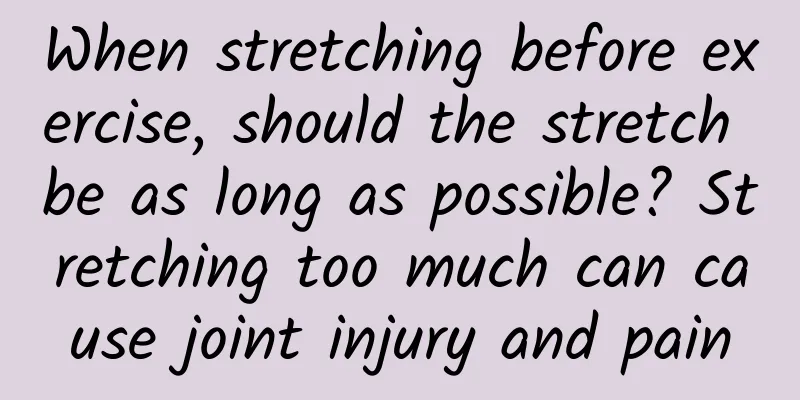When stretching before exercise, should the stretch be as long as possible? Stretching too much can cause joint injury and pain

|
If you do the wrong exercise, it may not have any effect and your work may be in vain. Conversely, if you exercise too much, you will suffer a lot! For example, some people think that the longer the tendons are stretched, the better, which leads to over-stretching, making the tendons too loose, the joints unstable, and even causing pain. What is the correct and effective way to "stretch", and what are the benefits to health? Let’s hear what the rehabilitation specialist has to say. Rehabilitation specialist Tu Liwen said that in her clinical outpatient work, she encountered more and more chaos in exercise. Some people regarded labor as exercise, some regarded activities as exercise, and some regarded exercise as training. In fact, labor, activities, exercise and training are completely different. If you confuse them, you will feel that it is useless to exercise all the time. Making the tendons "elastic" is the real benefit of stretching I believe everyone has had the experience of "stretching". When we were in elementary and junior high school, our teachers would lead us to stretch before physical education class. Or maybe we have become accustomed to it, and when we feel tight, stuck, or sore somewhere in our body, we will feel the need to stretch or stretch the tendons of the tight area. But what exactly are tendons? Stretching allows the tendons to lengthen and relax the muscles Most people may think of "tendons" as tendons, which are the parts that look white and taste soft and chewy. But in fact, tendons are not just tendons. The real meaning of "tendons" is "strong meat", so it should include "muscles" and "tendons". In terms of human body structure, the ends of muscles evolve into tendons, which are then connected to bones through tendons. Rehabilitation specialist Tu Liwen said in her new book "The Complete Book of Sports Function Restoration" that there are some wrong ideas that often cause people who exercise to suffer. For example, they think that the longer the tendons are stretched, the better. In fact, the function of muscles is to contract and generate force. These forces are transmitted to the bones through tendons. In order to withstand the force, tendons have evolved into very dense and strong tissues. Therefore, a common problem with tendons is that they easily become too short and too hard. If muscles are over-contracted for a long time, they will become too tight and too stretched. Therefore, when stretching, one should not only think about stretching the tendons and making them as soft as possible, but also be able to relax and soften the tight muscles. This is the correct and effective way to stretch. Is it better if the tendons are stretched longer? Are there less pains when the tendons are stretched the softer they are? Generally speaking, flexibility will gradually deteriorate with age. If you don't stretch your tendons, they will naturally become shorter and harder over time. However, people often overlook several very important issues. Although it is not good for the tendons to become shorter and harder, is it better if the tendons are stretched longer? Are the softer the muscles are, the less likely they are to cause pain or sports injuries? If the tendons are stretched too long, it will affect the athletic performance. If the tendons are too soft, they will not be able to protect the body. The answer to both questions above is no. The longer the tendons are, the better. For example, many dancers have very long and spread tendons, which allow them to perform many concave and flexion movements and stretch the limbs. However, dancers still have many pain problems and sports injuries, and the chances of them occurring are no less than that of ordinary people with stiff tendons. Why is this? First of all, as mentioned before, tendons are the combination of muscles and tendons, which are used to generate force and produce movement. If the tendons are stretched too long, the distance of muscle contraction will increase, and it will be relatively more strenuous to produce the same movement. Therefore, muscle strength will decrease, the speed of force generation will slow down, and agility will also deteriorate. For sports that require maximum muscle strength and explosive power, if the tendons are stretched too long and the muscles and tendons are too soft, athletic performance will deteriorate. The calf muscles and Achilles tendons of good sprinters are not too soft. Instead, they have a certain degree of hardness and tension. This is because when they run, the rebound force will be greater and faster, and the strength will not be wasted in soft muscles. Stretching too much will not protect the joints and may cause pain or injury Secondly, tendons (muscles and tendons) are tissues that surround bones and joints, helping ligaments to stabilize the joints. If the tendons are stretched too long and too loose, they will not be able to provide restraining force, the joints will become unstable, and the risk of sprain will of course increase. If you continue to exercise or compete under such circumstances, it is of course very easy to get sports injuries! Therefore, if you stretch too much, not only will it fail to protect your joints, it may also cause pain or injury. Based on the above two reasons, I hope everyone will forget the old idea that "the longer the tendons are stretched, the better". Allowing the tendons to have moderate elasticity and perfect tension will allow the body to move quickly and transfer force efficiently. At the same time, it can also protect and stabilize the joints. This is the correct way to stretch. Here are two exercises to stretch your hip joint: Stretching exercises - hip joint [Lying on your back with your knees hugged and your legs crossed to stretch] 1. Lie on your back, bend your right knee 90 degrees and step on the ground. Put your left foot on your right knee, push your left ankle down towards the floor, press your right thigh, and relax after about 6 seconds. 2. Wrap your hands behind your right thigh and pull your right knee toward your head, stretching the left piriformis muscle for about 10 seconds. Repeat 3 times. [Lunge and Stretch] 1. Stand, lift your right foot, bend your knee 90 degrees, press your right thigh with both hands, and lift your right leg up at the same time, hold for about 6 seconds. 2. Change to a lunge stance with the left foot in front and the right foot behind, press the body down, and feel the iliopsoas muscle fully stretched for about 10 seconds. Repeat 3 times. |
Recommend
What should be paid attention to in the treatment of endometrial tuberculosis
Endometrial tuberculosis is a common disease that...
Eat cucumbers, tomatoes and 7 other kinds of vegetables to lose weight and keep losing weight!
If you want to lose weight, vegetables are better...
What complications can irregular menstruation cause?
Menstrual disorders are a relatively serious dise...
What are the specific measures to prevent cervical hypertrophy?
It is also very important to do a good job of pre...
What is the situation when the leucorrhea increases and has a strange smell? It needs to be confirmed
For women who have increased vaginal discharge an...
What are the symptoms of endometrial tuberculosis and how to diagnose it
Endometrial tuberculosis is a gynecological disea...
Can I use suppositories to treat inflammation before my period?
Can I use suppositories to treat inflammation bef...
Drinking water helps you lose weight, are you drinking it right? Grasp the five golden hours and use the kettle to remind you not to miss them
The weather is scorching hot and you feel like yo...
What should I do when I encounter a plateau in my weight loss? 5 tips to increase your basal metabolic rate
When losing weight, no matter whether you "e...
What is the physical therapy for pelvic inflammatory disease?
What are the physical treatment methods for pelvi...
How can women prevent cervical erosion? 5 causes of mild cervical erosion
The grading method of cervical erosion is based o...
Treatment of pelvic inflammatory disease requires the following:
Pelvic inflammatory disease can cause great harm ...
What measures can be taken to detect irregular menstruation?
Most gynecological diseases are cured faster the ...
The harm of pelvic inflammatory disease to female fertility
For female friends, pelvic inflammatory disease i...
What to do with leftovers from the New Year holidays? Dr. Liu Boen: Reheating and eating in the wrong way can lead to weight gain
The Chinese New Year holiday is coming soon. Duri...









